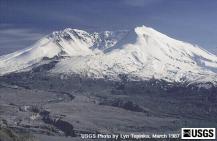16.1: Features of Volcanoes
- Page ID
- 16625
A volcano is an opening in the surface of the Earth from which magma (molten subsurface rock ) and associated gases and ash erupt; also, the form or structure, sometimes conical, that is produced by the ejected material. Volcanic activity may create vast plateaus where flood basalts emerge from cracks, covering the surface with massive flows of lava (molten rock above the surface) and subsequently dissected by streams.
Common to all volcanoes is a magma chamber  . The magma chamber is a huge, subterranean caldron of molten rock that is less dense than the surrounding rock and rises buoyantly, sometimes under great pressure to the surface. The main conduit through which magma moves toward the surface is the central vent. A crater sits at the top of a volcano and is the location where much of the lava, gas, rock fragments and ash are ejected from.
. The magma chamber is a huge, subterranean caldron of molten rock that is less dense than the surrounding rock and rises buoyantly, sometimes under great pressure to the surface. The main conduit through which magma moves toward the surface is the central vent. A crater sits at the top of a volcano and is the location where much of the lava, gas, rock fragments and ash are ejected from.

Lateral vents are found on the sides of some volcanoes where lava is extruded. An extremely large crater is some times found at the summit of a volcano. These massive craters called calderas, are created when pressure builds inside the volcano until the top is literally blown off, magma drains back into the central vent and the top of the cone collapses in. Crater lake formed in the caldera of Mount Mazama.
Video: "Crater Lake" courtesy of Britannica
Explore Crater Lake with Google Earth
Outpourings of magma can occur as a fluid-like lava  or as fiery clouds of ash and rock fragments. The ability of lava to flow depends on its viscosity or "stickiness". The viscosity of magma depends on temperature, silica content, and incorporated gases. Basaltic magma has approximately 50% SiO2, the smallest amount of incorporated gas and readily flows across the surface. Andesitic magma contains 60% SiO2 and has a substantial content of incorporated gas, giving it a moderate viscosity. Rhyolytic magma is 70% SiO2 and contains the largest amount of gas. Rhyolytic magma produces the highest viscosity lava and is responsible for violent eruptions.
or as fiery clouds of ash and rock fragments. The ability of lava to flow depends on its viscosity or "stickiness". The viscosity of magma depends on temperature, silica content, and incorporated gases. Basaltic magma has approximately 50% SiO2, the smallest amount of incorporated gas and readily flows across the surface. Andesitic magma contains 60% SiO2 and has a substantial content of incorporated gas, giving it a moderate viscosity. Rhyolytic magma is 70% SiO2 and contains the largest amount of gas. Rhyolytic magma produces the highest viscosity lava and is responsible for violent eruptions.

Volcanic eruptions, especially explosive eruptions, eject fragments of volcanic rocks and lava collectively called tephra  . Ground-hugging pyroclastic flows
. Ground-hugging pyroclastic flows  of fast-moving gas and fragments of rock having temperatures of 500 oC can rush down the flanks of a volcano at speeds reaching 100 km/hr, carbonizing all in their path.
of fast-moving gas and fragments of rock having temperatures of 500 oC can rush down the flanks of a volcano at speeds reaching 100 km/hr, carbonizing all in their path.
Volcanic eruptions are accompanied by the release of noxious and sometimes lethal gases. Steam makes up the majority of gas that is released by a volcano followed by carbon dioxide, sulfur dioxide, and hydrogen chloride. When lava spills into the ocean, the intense heating of salt water produces a noxious steam cloud of hydrochloric acid. Sulfur dioxide combines with water in the atmosphere to produce acid rain. Naturally produced acid deposition around the top of Mauna Loa has devastated the local vegetation.


